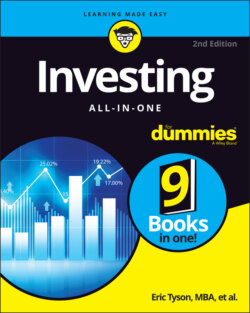Читать книгу Investing All-in-One For Dummies - Eric Tyson - Страница 100
Investing regularly with dollar cost averaging
ОглавлениеRegularly investing money at set time intervals, such as monthly or quarterly, in volatile investments such as stocks, stock mutual funds, or exchange-traded funds is called dollar cost averaging (DCA). If you’ve ever had money regularly deducted from your paycheck and contributed to a retirement savings plan investment account, you’ve done DCA.
Most folks invest a portion of their employment compensation as they earn it, but if you have extra cash sitting around, you can choose to invest that money in one fell swoop or to invest it gradually via DCA. The biggest appeal of gradually feeding money into the market via DCA is that you don’t dump all your money into a potentially overheated investment just before a major drop. No one has a crystal ball and can predict which direction investments will move next in the short term. DCA helps shy investors psychologically ease into riskier investments.
DCA is made to order for skittish investors with larger lump sums of money sitting in safe investments like bank accounts. It also makes sense for investors with a large chunk of their net worth in cash who want to minimize the risk of transferring that cash to riskier investments, such as stocks.
As with any risk-reducing investment strategy, DCA has its drawbacks. If growth investments appreciate (as they’re supposed to over time), a DCA investor misses out on earning higher returns on his money awaiting investment. Studying U.S. stock market data over seven decades, finance professors Richard E. Williams and Peter W. Bacon found that approximately two-thirds of the time, a lump-sum stock market investor earned higher first-year returns than an investor who fed the money in monthly over the first year.
However, knowing that you’ll probably be ahead most of the time if you dump a lump sum into the stock market is little consolation if you happen to invest just before a major drop in prices. For example, from late 2007 to early 2009, global stocks shed about half of their value. And how about those who invested in stocks in late 2019 and early 2020 only to see stocks slide by more than one-third in just a matter of weeks in March of 2020 due to the government-mandated economic shutdowns resulting from the COVID-19 pandemic?
If you use DCA too quickly, you may not give the market sufficient time for a correction to unfold, during and after which some of the DCA purchases may take place. If you practice DCA over too long a period of time, you may miss a major upswing in stock prices. Consider using DCA over one to two years to strike a balance. Alternatively, if you’re comfortable with the risk, get your money invested and get on with your life!
When you use DCA, establish an automatic investment plan so you’re less likely to wimp out of your strategy. Your money that awaits investment in DCA should have a suitable parking place. Consider a money market fund that’s appropriate for your tax situation.
